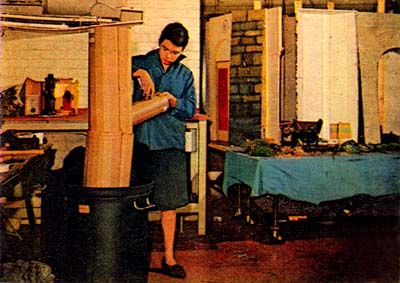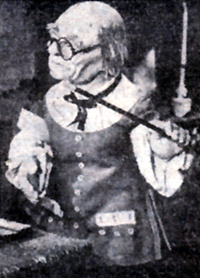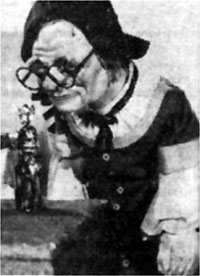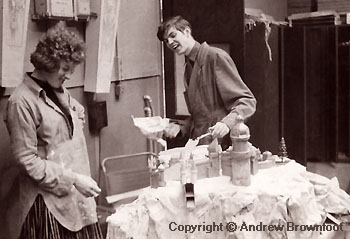| There
were two production of B&W ?Rubovian Legends?
marionette puppet plays. The first production, made in 1955,
consisted of just three plays, and was transmitted live from the
studio. Apart from one still photograph (printed in The Puppet
Master, June 1956), no recording exists of any of these. The
second production, which began in 1956 and lasted through 1965, is
the one remembered by most people familiar with ?Rubovian
Legends?. It consisted of twenty-six plays, two of which were
remakes from the first series.
The first production of three plays used
tiny (1/5 life-size) marionettes and scenery. The
marionettes were made by Kim Allen, borrowed
by Gordon from the BBC?s puppetry department. Settings and
costumes for the first two of these plays were
designed by Gordon Roland (The Queen?s Dragon) and Donald Horne
(Clocks and Blocks). No settings and costumes designer
credit was given for the third play (The Dragon?s
Hiccups), however, we do know that Rubovia designer Andrew
Brownfoot was involved with it, providing some new settings and a new
costume for the Queen.
The second production of twenty-six plays
used larger (1/3 life-size) puppets made by Gordon Murray for
which Andrew Brownfoot designed and made all the costumes and
scenery, with the assistance of his wife Margaret. Both
Andrew and Margaret were initially still studying Theatre Design at The Central School of Arts and Craft
in Holborn, but with encouragement from Jeanetta Cochranne, the Head of Theatre Design,
spent most of their time working for Gordon and the BBC.
|
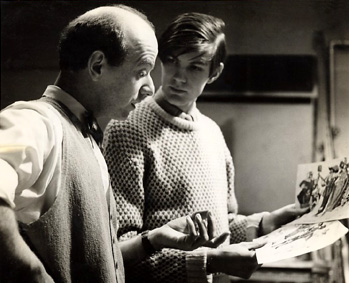
Gordon
Murray and Andrew Brownfoot discuss some of Andrew?s
costume designs for a non-Rubovian puppet play, The
Emperor?s New
Clothes. Tin Shed, 1959
Publicity
photo ? BBC
|
In the early days of
?Rubovian Legends? production, there were many challenges to be overcome.
For instance, there existed within the culture of the BBC, an
expectation that Gordon would use existing resources for scenery,
puppets, and costumes, etc. After starting with these, Gordon
quickly developed a very clear vision of what he wanted to
achieve, a vision that could not be confined within the limits of
what had already been done by others. His artistic vision required
a more advanced marionette puppetry format, with larger,
flexible-faced, moving-mouth puppets, professional voice-actors,
and larger scenery to match. He also needed to have artistic
freedom. In the end this was recognised by the BBC, and Gordon was
left to his own devices, which he loved. However this recognition
did not come with a budget to match, and so when Gordon needed a
sewing machine, money was tight and he was not able to requisition
one. As a result, unconventional solutions were the order of the
day. Gordon said in a 1959 interview (Puppets in a Hot Tin Shed,
by Roger Watkins, The Stage and Television Today, May 7, 1959,
p.12), ?I?ve broken every rule the BBC has ever made. Most of the things I do are highly
illegal?like buying a sewing machine on the petty cash, for instance. You just
mustn?t run up huge bills on the petty cash like I do.?
If the BBC was turning a blind eye to any of Gordon?s activities,
it was probably because his puppet plays were selling well
overseas, and were doing well in the UK as well. After the much
needed sewing machine was obtained, it was quickly put to good use by Andrew
Brownfoot, to make the intricate (1/3 life-size) miniature costumes for all of the puppets.
And when the petty cash would not extend to some need, Gordon
often bought it out of his own pocket. Such was his level of
dedication and desire to make the puppet productions the best that
they could be.
|
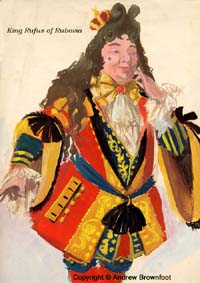
Andrew
Brownfoot?s
design for King Rufus of Rubovia, c. 1957
Illustration
courtesy of A. Brownfoot
(click
for larger image 70K) |
Looking around the
Tin Shed workshop area, the viewer would notice all sorts of materials which were needed on hand to create the world of Rubovia.
Liquid rubber for heads, plastics, moulds, paints, wood, glue, wire, the celebrated sewing machine, fabric, and props galore. An
exquisite four-foot-long model of Rubovia castle and its backdrop
of snowy mountains could easily catch your eye there, along with fancy fireplaces, four-poster beds,
all to Andrew Brownfoot?s designs in expanded polystyrene, a kind
of plastic so airy and light,
?that a puppet?s cough would blow it up the chimney.? (Come to the Puppet
Theatre! by Earnest Thomson, Supplement to Radio Times,
December 4th, 1959). In
fact you?d have seen pretty much anything one would expect to see gracing the interior of a
castle, such as miniature paintings, wall hangings, drapes, tiled
floors, Louis XIV style chairs and tables. Then there were props for the outdoor scenes as well, including anything related to Queen
Caroline?s famous
cabbage patch.
|
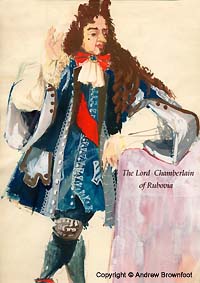
Andrew
Brownfoot?s
design for the Lord Chamberlain of Rubovia, c. 1957
Illustration
courtesy of A. Brownfoot
(click
for larger image 70K) |
Rubovia was very much a team effort. It
would go like this: Gordon gets an idea of what he wants to do and
tells Andrew who starts making rough designs of the costumes and
scenery. When they have agreed on how it should look, Gordon
starts work on making the puppets, Andrew builds the scenery and
makes the puppet costumes. When the puppets are completed, Andrew
paints their faces and Andrew?s wife Margaret assists with making
finishing touches such as make-up and styling the hair. The after
the puppets are dressed and Gordon has completed the script,
rehearsals start with the puppeteers. There was a large area available in the Tin Shed for this, which allowed for three puppet stages to be set up at the one time.
The first few ?Rubovian Legends? plays were sent out
live, in front of the television camera. On the day of
transmission, everything had to be taken down and then re-erected in the
television studio, in time for one or two last camera rehearsals
before the play went on air at 5:00 pm.
|
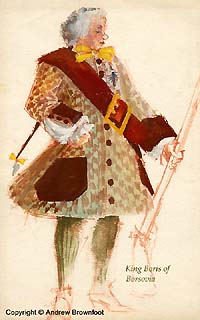
Andrew
Brownfoot?s
design for King Boris of Borsovia, c. 1957
Illustration
courtesy of A. Brownfoot
(click
for larger image 70K)
|
Live transmission was a very demanding and tense situation for all those involved. The puppets themselves were rather heavy, and
the movements required of them took considerable skill and strength. Now and then the unexpected occurred, such as a puppet falling over, or strings becoming tangled.
The technology of tele-recording had not been developed yet, and
nor was filming the norm, so there was no possibility of editing
out mistakes, and once the transmission was over, six weeks of
hard work were down the tubes, figuratively speaking. By 6:00 pm
the scenery was being torn down to make way for another
transmission, and everyone involved in the production would rush
over to the BBC club to wind down and recover from an extreme
sense of anticlimax.
|

Andrew
Brownfoot?s
design for Sir Albert Weatherspoon,
Royal Gardner at the court
of Rubovia, c. 1957
Illustration
courtesy of A. Brownfoot
(click
for larger image 62K)
|
Gordon said recently of Andrew Brownfoot
(July 2003) that he admired Andrew?s talent a lot, and was very
surprised and sometimes amazed at the wonderful costumes and sets
that Andrew had come up with at such a young age. Gordon added
that he had not expected a boy of seventeen to be so talented and
capable, doing things so well, even doing all his own research for
the costumes and sets.
Almost
fifty years after he painted them, Andrew Brownfoot's design
pictures of
the ?Rubovian Legends? characters still look as fresh as the day
the paint dried. The final look of the Rubovian puppets and their
costumes turned out quite close to these designs, the biggest
difference
being with King Boris of Borsovia, who developed from the original
conception somewhat. As recalled by Andrew (Dec 2003), ?In the
end, Boris was given a moustache and his cravat had a design of
horses heads, to make him look like a typical ?huntin?, shootin?,
and fishin?? type.?
|





